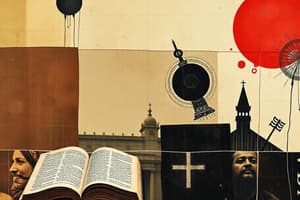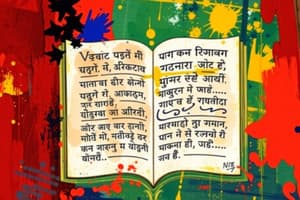Podcast
Questions and Answers
What is the main characteristic of the Rig Veda?
What is the main characteristic of the Rig Veda?
- It is a narrative epic about two royal families.
- It is composed of prose mantras for rituals.
- It focuses solely on healing spells.
- It is a collection of hymns dedicated to deities. (correct)
Which Veda contains chants and melodies specifically for rituals?
Which Veda contains chants and melodies specifically for rituals?
- Yajurveda
- Atharveda
- Samaveda (correct)
- Rig Veda
What theme is prominently explored in the Ramayana?
What theme is prominently explored in the Ramayana?
- Political intrigue
- Economic prosperity
- Duty and loyalty (correct)
- Asceticism and renunciation
Which of the following is NOT considered a major collection of the Vedas?
Which of the following is NOT considered a major collection of the Vedas?
What does the term 'Sanskrit' refer to in the context of literature?
What does the term 'Sanskrit' refer to in the context of literature?
What is a common theme found in The Thousand and One Nights?
What is a common theme found in The Thousand and One Nights?
In comparing the Mahabharata and the Ramayana, which element is a key difference?
In comparing the Mahabharata and the Ramayana, which element is a key difference?
Which story features characters like Aladdin and Sinbad?
Which story features characters like Aladdin and Sinbad?
Which of the following works is a significant collection of ancient Japanese poems from the Nara period?
Which of the following works is a significant collection of ancient Japanese poems from the Nara period?
What is a central theme of The Tale of Genji by Murasaki Shikibu?
What is a central theme of The Tale of Genji by Murasaki Shikibu?
Which literary work is traditionally credited to Otomo no Yakamochi?
Which literary work is traditionally credited to Otomo no Yakamochi?
Which of the following best describes the narrative style of The Tale of Genji?
Which of the following best describes the narrative style of The Tale of Genji?
In Japanese poetry history, which period is The Manyoshu associated with?
In Japanese poetry history, which period is The Manyoshu associated with?
What is a primary focus of naturalism as a principle in literature?
What is a primary focus of naturalism as a principle in literature?
Which principle is represented by the concept of Yin and Yang?
Which principle is represented by the concept of Yin and Yang?
What role does simplicity and humility play in literature and philosophy?
What role does simplicity and humility play in literature and philosophy?
Which statement about Confucius's perspective on knowledge is accurate?
Which statement about Confucius's perspective on knowledge is accurate?
What are the five constant relationships in Confucian philosophy?
What are the five constant relationships in Confucian philosophy?
Which quote is attributed to Confucius?
Which quote is attributed to Confucius?
What does the term 'Tao' refer to in Taoism?
What does the term 'Tao' refer to in Taoism?
What role does Confucius see for individuals in society?
What role does Confucius see for individuals in society?
What defines the focus of the philosophical text 'Analects'?
What defines the focus of the philosophical text 'Analects'?
How has Chinese literature influenced other Asian countries?
How has Chinese literature influenced other Asian countries?
Which aspect is essential to understanding Confucian teachings?
Which aspect is essential to understanding Confucian teachings?
Flashcards
Vedas
Vedas
The oldest sacred texts in Hinduism, comprised of four main collections.
Rig Veda
Rig Veda
One of the oldest Hindu sacred texts, containing hymns dedicated to deities.
Mahabharata
Mahabharata
An Indian epic poem about two royal families competing for a throne.
Ramayana
Ramayana
Signup and view all the flashcards
Sanskrit
Sanskrit
Signup and view all the flashcards
The Thousand and One Nights
The Thousand and One Nights
Signup and view all the flashcards
Khun Chang Khun Phaen
Khun Chang Khun Phaen
Signup and view all the flashcards
The Tale of Lady Kieu
The Tale of Lady Kieu
Signup and view all the flashcards
Tao
Tao
Signup and view all the flashcards
Wu-Wei
Wu-Wei
Signup and view all the flashcards
Yin and Yang
Yin and Yang
Signup and view all the flashcards
The Manyoshu
The Manyoshu
Signup and view all the flashcards
Lady Murasaki Shikibu
Lady Murasaki Shikibu
Signup and view all the flashcards
The Tale of Genji
The Tale of Genji
Signup and view all the flashcards
Confucianism
Confucianism
Signup and view all the flashcards
Yijing (Classic of Changes)
Yijing (Classic of Changes)
Signup and view all the flashcards
What is The Analects?
What is The Analects?
Signup and view all the flashcards
What is Lunyu?
What is Lunyu?
Signup and view all the flashcards
Confucius's Philosophy
Confucius's Philosophy
Signup and view all the flashcards
5 Relationships in Confucian Philosophy
5 Relationships in Confucian Philosophy
Signup and view all the flashcards
Five Classics
Five Classics
Signup and view all the flashcards
Tao Te Ching
Tao Te Ching
Signup and view all the flashcards
Influence of Chinese Literature
Influence of Chinese Literature
Signup and view all the flashcards
Study Notes
21st Century Literature from the Philippines and the World
- This is a broad topic encompassing Asian literature from various countries.
- The literature reflects the evolution of civilizations, major religions, wars, and political revolutions.
- These events have inspired masterpieces influencing Asian traditions, cultures, and lifestyles.
Asian Literature
- Asia is home to many literary masterpieces.
- These works chronicle the development of civilizations, religions, conflicts, and political changes.
- These events have significantly impacted the cultures and traditions of Asian countries.
Chinese Literature
-
Chinese literature's content is deeply rooted in philosophical inquiries about life, ethics, and spiritual harmony with nature.
-
Poetry is highly valued and reputed to be superior to prose in Chinese literature.
-
Chinese literature has influenced the literary traditions of other Asian countries, particularly Korea, Japan, and Vietnam.
-
The Analects (Lun Yu): This text emphasizes moderation through moral education for harmonious family life and virtuous development. It also stresses filial piety and social/religious rituals.
-
The Analects is also known as the Sayings of Confucius. It's an ancient Chinese philosophical text.
-
Confucius was one of Asia's most influential teachers and philosophers. He believed individuals should understand their place in the world and cultivate inherent goodness through proper conduct toward others.
-
Five Classics of Confucian Philosophy (Wu Jing): Compilation representing the coming of age of Confucianism.
- Yijing (Classic of Changes): Metaphysical vision (divination and numerology).
- Shujing (Classic of History): Political vision (humane government).
- Shijing (Classic of Poetry): Poetic vision (valuing common human emotions).
- Liji (Record of Rites): Social vision (society as a trust-based community).
- Chunqiu (Spring and Autumn Annals): Historical vision (importance of collective memory).
-
Tao Te Ching (Classic of the Way of Power): Foundation of Taoism. It explains the basic concept of "wu wei" (non-action) implying spontaneity, non-interference, and letting things take their natural course.
- Taoism is a philosophy focusing on living in accordance with the fundamental principle of Tao (the Way).
- Fundamental Principles of Taoism:
- Tao (the Way): Ultimate principle unifying all things in the universe.
- Wu Wei (Non-Action): The concept of taking action in harmony with the natural flow of the universe.
- Yin and Yang: Representing dualistic, complementary, interconnected, and interdependent forces.
- Simplicity and Humility: Important values.
- Naturalism: Living in accordance with nature.
Japanese Literature
- Early Japanese literature was influenced by Chinese culture.
- Poetry evolved as a popular means of expression.
- Manyoshu (Book of Ten Thousand Leaves): An anthology of poetry from different social classes (peasants, clergy, and the ruling class). It's considered a literary classic and a high point of Japanese poetry (4,500 poems). It was compiled during the Nara Period.
- The Tale of Genji by Lady Murasaki Shikibu: Considered the world's first true novel, it's a lengthy and complex work about the life of a gifted and charming prince navigating love, loss, and court life. It was written in the early 11th century.
Indian Literature
- Ancient Indian literature lacked novels and short stories but emphasized poetry and drama.
- Most Sanskrit texts aimed to convey timeless truths.
- Hinduism considers the Vedas as the source of its religious beliefs.
- Sanskrit: An ancient language used for Hindu liturgical practices, classical literature, philosophy, and science.
- Vedas: Ancient sacred texts in Hinduism; There are four main collections, each focusing on different aspects:
- Rig Veda: Collection of hymns honoring deities, the Gayatri Mantra is a well-known example
- Samaveda: Focuses on melodies and chants used in rituals
- Yajurveda: Contains prose mantras used in sacrificial rituals
- Atharvaveda: Includes hymns and spells for daily life and healing.
- Mahabharata: The world's longest epic poem, explaining dharma (codes of conduct) for kings, warriors, people in times of crisis, and those seeking spiritual liberation. It recounts the story of two royal families (Pandavas and Kauravas) competing for the throne.
- Ramayana: Reflects Hindu values, social organization, the theory of karma, ideals of wifehood, and feelings about caste, honor, and promises. It centers on Rama's quest to rescue Sita from the demon king Ravana.
- Panchatantra: Collection of Indian fables intended as a textbook of worldly wisdom (artha).
Arabic Literature
- By the time of Muhammad's birth, Arabs already had a significant body of poetry.
- Poetry was used for praising tribes, critiquing others, and preserving cultural memories before Islam.
- The Thousand and One Nights (Arabian Nights): A collection of stories with themes of fate, morality, and storytelling. Famous characters like Aladdin, Sinbad, and Alibaba appear in these tales.
Southeast Asian Literature
- Southeast Asian literature blends various traditions, cultures, and beliefs.
- Oral transmission is prevalent.
- Chinese and Indian influences are notable.
- Khun Chang Khun Phaen (Thailand): Story about wealthy and poor suitors competing for the love of the same woman, dealing with heroism and humor.
- The Tale of Lady Kieu (Vietnam): A lengthy poem about a talented and beautiful woman. It incorporates elements from Chinese tradition and syncretic spiritual beliefs.
Additional Questions (Based on last slide)
- Are there any notable similarities between Asian and Philippine literary works? What are they?
Studying That Suits You
Use AI to generate personalized quizzes and flashcards to suit your learning preferences.




